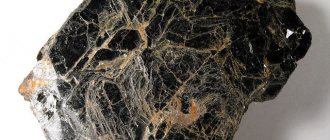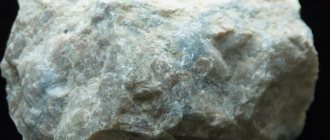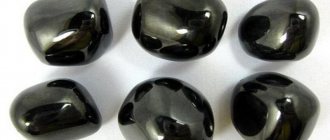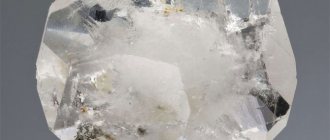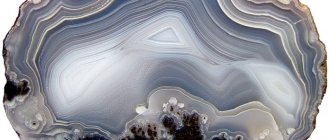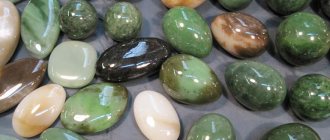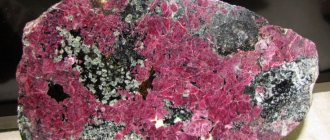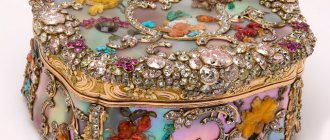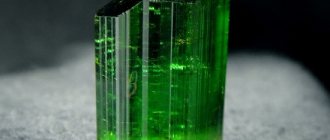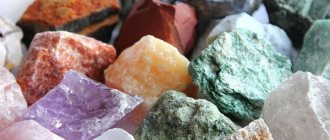The mineral called celestine is made up of strontium sulfate. The Latin term "celestis" translates as "heavenly", that is, the name of this stone indicates its delicate blue color. But there are also blue-gray, yellow and even red celestines. All of them are transparent or translucent and resemble barite in structure. Celestite is distinguished from the last, outwardly very similar mineral by the color of its flame. While calcination of barite in it produces a green tint, celestine in such conditions develops a bright crimson color.
Celestine deposits
Celestine is a common rock with many deposits known on all continents.
Thus, sky-blue crystals are mined on the island of Madagascar, and transparent crystals are mined in Austria. Collectible transparent samples, painted in red-brown tones, are found in the mines of Turkmenistan. In the mountains of Dagestan, rich blue stones are mined. — Advertising —
Celestine is also mined in Italy and the UK, USA and Canada. Large deposits are located in Mexico, China, Iran and Turkey. Suppliers of gem quality stone samples are Germany and Spain. Russian deposits are also known.
History of celestine
The first Celestines were discovered in the 18th century on the island of Sicily, and they were initially called “Sicilianites.”
But later this name was considered dissonant, and at the suggestion of the German scientist Abraham Werner, the stone was renamed “celestine.” This term is of Latin origin and goes back to the word “caelestis”, which translates as “heavenly” and refers to the characteristic blue color of the gem. The samples discovered in Sicily had a somewhat blurred blue color, but it turned out that celestine crystals of other colors are also found in nature.
However, the second name for the mineral has been preserved and entrenched in modern mineralogy.
Characteristics of the mineral
All of these translation options are, in one way or another, related to the color, which is light blue in color, inevitably reminding people of the color of the sky. It is often confused with other minerals of a similar shade: dolomite, calcite, barite. The first has a characteristic shape, calcite is often colorless rather than light blue. The latter is much heavier. The surest way to find out if a mineral is celestine is to heat it, then it will turn red, but it is better not to do this unless absolutely necessary.
The most common forms that natural stone takes are:
- pillar;
- prism;
- thick plate.
The mineral most often fills cavities and simple cracks in rocks , which is where it is easiest to find.
As for color, light blue and greenish stones are most often found, but brown plates with various shades can also be found.
Physico-chemical characteristics of celestine
Celestine consists of strontium sulfate.
Its crystals have a monoclinic system, perfect cleavage, irregular fracture, glassy or pearlescent luster. Pure strontium sulfate is colorless, but impurities can give it a wide variety of shades. — Advertising —
The hardness of the mineral is 2 on the Mohs scale. Density is 2.3-2.4 g/cm3. Brittle, soluble in water, prone to fading in the sun.
When the mineral is added to the flame, it turns reddish. If celestine contains impurities, fluorescence may appear in the ultraviolet spectrum.
In natural geodes, celestite forms large (tens of kilograms) crystals and druses of large volumes.
Celestine mineral: properties and description, formula
Celestine mineral photo The first samples of this beautiful mineral were found on the island of Sicily about 200 years ago.
According to the place where it was found, it was called sicilianite, but this unpronounceable name was later replaced.
The celestite stone owes its modern name to its sky-blue color (“celestis” translated from Latin as heavenly).
Celestine is strontium sulfate. It is a transparent or translucent crystals of prismatic or columnar shape.
The color of the mineral is light blue or light gray, sometimes with a purple, yellow or red tint.
It is found in geode cavities of sedimentary rocks, often forming spherulites - spherical accumulations of crystals or druses - columnar crystals with a common base.
Interestingly, the presence of celestine has been established in the skeletons and shells of some marine organisms. It is possible to obtain the mineral artificially.
Physical properties of celestine
Over several centuries, scientists managed to fully study the mineral.
The following physical properties were identified:
- with prolonged exposure to sunlight, the crystal turns gray;
- celestine, when exposed to fire, changes color to bright red;
- when heated to 200 degrees Celsius, the color of the stone disappears;
- glassy sheen on the surface;
- the mineral does not have high strength. Mechanical impact will cause scratches.
Chemical properties of celestine
Chemical formula of celestine: SrSO4.
The ratio of components in the composition of the stone is almost equal: SrO - 55%, SO3 - 43%. The proportion of impurities can reach 3%.
Among the chemical properties of the mineral are:
- hardness on the Mohs scale - 3.7 units;
- density - 4.1 g/cm3;
- most often there are specimens with calcium and barium inclusions;
- concentrated sulfuric acid can dissolve the mineral.
The magical properties of celestine
Celestine is a positive and benevolent mineral that has a beneficial effect on a person’s mood.
It is used during meditation. Celestine will give the male owner self-confidence, and the woman - a sense of her own charm and attractiveness. Amulets with celestines also help women cope more easily with personal dramas, separation from a loved one, and gives strength during difficult periods in life. Talismans with this gem are also recommended for overly suspicious and emotional people; they will help them to be calm in difficult situations, to think clearly when necessary, to make quick and correct decisions. Celestine is also considered a stone for talented people. He awakens hidden possibilities and potentials in them, imparts eloquence, and eliminates the fear of speaking in front of a large audience. For maximum effect in this direction, it is important to contact the stone every day.
The healing properties of celestine
To date, lithotherapy has studied little of the healing properties of celestine.
It is known to normalize blood pressure, improve blood circulation and permeability of vascular walls, and relieve rheumatic pain. Celestine is also used in the treatment of eye diseases; the mineral is also used to restore vision. As for the nootropic effect of celestine, the mineral is used carefully, since it alternates between an increase in mental activity and its inhibition, emotional decline and sleep. In order for the power of the stone to have a positive effect, and for the mineral not to have a negative impact on health and mental state, it is important to find a match between the daily rhythm of the person and the gem.
Therapeutic qualities
Celestine has been little studied by lithotherapists as a healing stone. But nevertheless, it is characterized by the amazing healing abilities that are inherent in all natural blue crystals. It has a beneficial effect on the cardiovascular system, with the following observed:
- Blood pressure is normalized in hypertension and hypotension.
- Blood circulation in blood vessels and capillaries improves.
- The veins are cleansed, which helps cure varicose veins and thrombosis.
- The flexibility and elasticity of the walls of blood vessels is restored, their lumens become the same, due to this they return to natural functioning.
- Relieves the condition during rheumatic attacks of pain.
- Effective for diseases of the organs of vision and for its restoration.
- It has a nootropic effect that must be used very carefully. The mineral’s own rhythms affect mental activity, changing them with the stages of inhibition, emotional decline and sleep. Therefore, in order for a beneficial effect to be produced on the body, it is necessary to subordinate the rhythms produced by the stone to your human daily cycle. Otherwise, the owner of celestine will begin to have serious problems with sleep, fear and anxiety will appear, depression and severe psychological disorders may develop.
Branches of application of celestine
Strontium, the main component of celestine, is used for the pharmaceutical, ceramic, glass and pyrotechnic industries.
In metallurgy, strontium is used to alloy alloys and provide hardness to copper and aluminum, as an anti-corrosion coating in aircraft alloys and for zinc. In the 20th century, strontium was used in the manufacture of sparklers, fireworks and rockets. Now strontium nitrate, which is isolated from celestines, is part of red fireworks. Occasionally, celestine is also used in jewelry, but it is very complex in cutting and processing, and therefore products made from it, as a rule, are single copies. It is not allowed to treat celestine with X-rays, as this increases the radiation of strontium atoms, which can cause harm to human health.
Practical use
- One of the main components of the mineral is strontium, which is actively used in various industries, in particular industrial and pharmaceutical;
- Also found use in the production of ceramics, glass and pyrotechnics;
- It is actively used in metallurgy, since strontium helps to make copper hard and is one of the components of anti-corrosion coatings;
- Today, strontium nitrate, which scientists have learned to isolate from the mineral, is included in the components of fireworks and fireworks;
- It is worth noting that jewelers practically do not use it to make jewelry, since the most qualified specialists undertake its cutting. X-ray treatment is not suitable for him, since the strontium contained in celestine will have a negative effect on humans. Jewelry made from this amazing stone is rare and is not mass-produced.
Magical influence
- Thanks to the friendly and positive vibrations of the stone, the mood of those around you will change for the better, and it is also used by yogis for meditation;
- Recommended for wearing by men who feel self-confident and important;
- It is useful for women because it helps to reveal their inner charm and makes them more attractive in the eyes of the opposite sex;
- Regular contact with the mineral is worth keeping for talented individuals, for whom the stone will help reveal hidden talents and reveal their potential;
- Celestine will be useful for people who often speak in public. The owner will gain eloquence and get rid of the fear of large crowds of people;
- The stone is great as a talisman. For women, it will add moral strength to survive various serious situations or a breakup with a man. In particular, it will raise the morale of weak and shy people, give them the ability to quickly navigate in extreme situations and think correctly in the right direction;
- Celestine is recommended to be worn by designers, writers, and architects.
Influence on Zodiac signs
Gemini's favorite minerals. But the study by astrologers of the impact of the stone on other signs is still being studied. One thing is known - Celestine is universal and suitable for everyone.
Therapeutic effect
Lithotherapists are still studying this amazing mineral, but some information is still known.
- It helps hypertensive and hypotensive patients normalize blood pressure, improves blood circulation;
- Regular contact will help reduce pain from rheumatism and other joint diseases;
- It is also suitable for improving vigilance; it is enough to peer into its depth several times a day;
- Given the nootropic properties of the stone, it should be handled carefully, since celestine vibrations can alternate stages of inhibition with increased mental activity. To get help from Celestine, it is important to establish contact with him. Otherwise, a person may experience insomnia and nightmares.
- The mineral should also be worn by people who care about their figure and health.
How to care
It is worth noting that the gem is not hard or durable, so it is easy to scratch or break. It should be stored in a separate box with a fabric backing. Do not clean it under running water. A soft damp cloth is enough. It should also not be exposed to ultraviolet light.
How to care for celestine
Celestine is a very soft and fragile stone; it is stored separately from other stones and protected from mechanical damage, shock, scratches and chips. For jewelry, velvet bags or boxes with soft walls are suitable. If the product needs to be cleaned, use a damp soft cloth. It is not recommended to dry celestine in the open sun, as well as to expose it to prolonged exposure to direct sunlight. In bright light and high humidity, the mineral quickly loses its qualities.
Celestine and the zodiac sign
The real favorites of celestine in the zodiac are Gemini. As for representatives of other zodiac signs, the exact influence of the stone on them is currently unknown. Celestine helps all people of creative professions, without exception, including writers, artists, constructors, designers and architects, regardless of zodiac affiliation.
Celestine stone: who suits it according to their zodiac sign
The effect of celestine on zodiac signs has not been fully studied.
In the European tradition, astrologers associate celestine stone with the spring-summer zodiac constellation Gemini (May 21 - June 20), and attribute this mineral to the element of Air.
However, we should not forget that its characteristic feature is the high probability of containing radioactive elements. This is especially true for stones that have a rich blue color.
Prices for celestine products
Facet-cut celestine is expensive on the jewelry market because it is rare. Collectible specimens of this stone are more common. For example, the cost of a high-quality druse weighing 70 grams, set in silver, is $500-700. The ball, carved from celestine, weighs about 2 kg, is valued at $200. But a bracelet made of large beads of opaque celestine is inexpensive: 8-10 dollars.
Celestine interior decorations are very popular today. In this regard, the “chrysanthemum stone”, which is a small but beautiful cluster of celestines, is in demand. Rosettes made of sparkling white crystals look great against a background of black granite or slate.
Interesting facts about celestine:
- In the state of Ohio in the USA, there is the largest celestine geode (“Crystal Cave”), which reaches a diameter of 10 m. Now it has been equipped as an object for tourists to visit, and among the celestine crystals there are samples about 1 m long.
- According to the Chinese legend about the origin of celestine, demons who hated beauty once settled in one of the most beautiful places on our planet. They filled everything around them with liquid mud. But the heavenly forces burned the demons, and the soil at the site of the fire petrified, and seeds fell from heaven onto the damaged earth, which became sprouts in the thickness of the fossils. It is these sprouts that are celestines.
- In Europe, celestines were associated with a different story. The name Celestine in the Middle Ages was the personification of light, purity and infallibility, as it was borne by a Benedictine monk who lived in the 13th century, led a hermit life and was elected pope, but renounced his high rank. It is believed that a stone rosette of the mineral celestine, similar to a chrysanthemum, can reveal its beauty only to a righteous saint.
